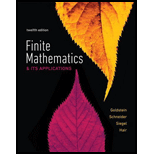
In Exercises 37–40, use a Venn diagram similar to the one in Fig. 1 to solve the problem.
Suppose that
Find (a)
Want to see the full answer?
Check out a sample textbook solution
Chapter 6 Solutions
Finite Mathematics & Its Applications (12th Edition)
- Given the graph of f(x) below. Determine the average rate of change of f(x) from x = -2 to x = 2. Give your answer as a simplified fraction if necessary. For example, if you found that msec = , you would enter 3 2 2 3 X 23arrow_forward29 Probability Theory: Central Limit Theorem Task: Refer to Question 29 in the provided document. Link: https://drive.google.com/file/d/1wKSrun-GlxirS3IZ9qoHazb9tC440AZF/view?usp=sharingarrow_forwardnot use ai pleasearrow_forward
- List the possible values of a for which square root is between 6 and 7 and an element of natural numberarrow_forwardQuestion 25 Jasmine bought a house for $225 000. She already knows that for the first $200 000, the land transfer tax will cost $1650. Calculate the total land transfer tax. (2 marks) Land Transfer Tax Table Value of Property Rate On the first $30 000 0% On the next $60 000 0.5% (i.e., $30 001 to $90 000) On the next $60 000 1.0% (i.e., $90 001 to $150 000) On the next $50 000 1.5% (i.e., $150 001 to $200 000) On amounts in excess of $200 000 2.0% 225000–200 000 = 825000 25000.002 × 25000 1= 8500 16 50+ 500 2 marksarrow_forwardTaxable income (R) 1-216 200 216 201-337 800 337 801-467 500 2021/2022 TAX YEAR Rates of tax (R) 18% of taxable income 38 916 +26% of taxable income above 216 200 70 532 + 31% of taxable income above 337 800 110 739 + 36% of taxable income above 467 500 467 501-613 600 613 601-782 200 163 335 + 39% of taxable income above 613 600 782 201-1656 600 229 089 +41% of taxable income above 782 200 4 1 656 601 and above 587 593 + 45% of taxable income above 1 656 600 TAX REBATES • A special relief/discount given to taxpayers. It is subtracted after the income tax has been calculated. • Every person qualifies for primary rebate. Older people are granted additional rebate i.e. If you are older than 65 years of age you will receive Primary and secondary rebate; If you are over 75 years you will receive primary, secondary, and tertiary rebate. Tax rebate type Primary (age below 65) Secondary (65 to 74) Tertiary (75 and older) 2021 R14 958 2022 R15 714 R8 199 R8 613 R2 736 R2 871 • TAX THRESHOLD…arrow_forward
- 25 Topology: Properties of Compact Spaces Task: Refer to Question 25 in the provided document. Link: https://drive.google.com/file/d/1wKSrun-GlxirS3IZ9qoHazb9tC44OAZF/view?usp=sharingarrow_forward4 6 Spectral Theory: Eigenfunctions and Eigenvalues Task: Refer to Question 46 in the provided document. Link: https://drive.google.com/file/d/1wKSrun-GlxirS3IZ9qoHazb9tC440AZF/view?usp=sharing 47 Category Theory: Functors and Natural Transformations Task: Refer to Question 47 in the provided document. Link: https://drive.google.com/file/d/1wKSrun-GlxirS3IZ9qoHazb9tC440AZF/view?usp=sharingarrow_forward= Consider the vector space R² with the standard basis {e1 {v1 = (1, 1), V2 = = (1, 0), e2 = (0, 1)} and a new basis new basis. (1,-1)}. a) Find the change of basis matrix from the standard basis to the b) Express the vector w = (2, 3) in the new basis {V1, V2}.arrow_forward
- 28 Real Analysis: Uniform Convergence Task: Refer to Question 28 in the provided document. Link: https://drive.google.com/file/d/1wKSrun-GlxirS3IZ9qoHazb9tC440AZF/view?usp=sharing 29 Probability Theory: Central Limit Theorem Task: Refer to Question 29 in the provided document.arrow_forward53 Ergodic Theory: Poincaré Recurrence Theorem Task: Refer to Question 53 in the provided document. Link: https://drive.google.com/file/d/1wKSrun-GlxirS3IZ9qoHazb9tC440AZF/view?usp=sharing 54 Graph Theory: Eulerian and Hamiltonian Paths Task: Refer to Question 54 in the provided document. Link: https://drive.google.com/file/d/1wKSrun-GlxirS3IZ9qoHazb9tC440AZF/view?usp=sharingarrow_forward38 Mathematical Logic: Gödel's Incompleteness Theorems Task: Refer to Question 38 in the provided document. Link: https://drive.google.com/file/d/1wKSrun-GlxirS3IZ9qoHazb9tC440AZF/view?usp=sharingarrow_forward
 Discrete Mathematics and Its Applications ( 8th I...MathISBN:9781259676512Author:Kenneth H RosenPublisher:McGraw-Hill Education
Discrete Mathematics and Its Applications ( 8th I...MathISBN:9781259676512Author:Kenneth H RosenPublisher:McGraw-Hill Education Mathematics for Elementary Teachers with Activiti...MathISBN:9780134392790Author:Beckmann, SybillaPublisher:PEARSON
Mathematics for Elementary Teachers with Activiti...MathISBN:9780134392790Author:Beckmann, SybillaPublisher:PEARSON
 Thinking Mathematically (7th Edition)MathISBN:9780134683713Author:Robert F. BlitzerPublisher:PEARSON
Thinking Mathematically (7th Edition)MathISBN:9780134683713Author:Robert F. BlitzerPublisher:PEARSON Discrete Mathematics With ApplicationsMathISBN:9781337694193Author:EPP, Susanna S.Publisher:Cengage Learning,
Discrete Mathematics With ApplicationsMathISBN:9781337694193Author:EPP, Susanna S.Publisher:Cengage Learning, Pathways To Math Literacy (looseleaf)MathISBN:9781259985607Author:David Sobecki Professor, Brian A. MercerPublisher:McGraw-Hill Education
Pathways To Math Literacy (looseleaf)MathISBN:9781259985607Author:David Sobecki Professor, Brian A. MercerPublisher:McGraw-Hill Education





